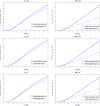Modeling the impact of the vaccine on the COVID-19 epidemic transmission via fractional derivative
- PMID: 35845824
- PMCID: PMC9272881
- DOI: 10.1140/epjp/s13360-022-02988-x
Modeling the impact of the vaccine on the COVID-19 epidemic transmission via fractional derivative
Abstract
To achieve the goal of ceasing the spread of COVID-19 entirely it is essential to understand the dynamical behavior of the proliferation of the virus at an intense level. Studying this disease simply based on experimental analysis is very time consuming and expensive. Mathematical modeling might play a worthy role in this regard. By incorporating the mathematical frameworks with the available disease data it will be beneficial and economical to understand the key factors involved in the spread of COVID-19. As there are many vaccines available globally at present, henceforth, by including the effect of vaccination into the model will also support to understand the visible influence of the vaccine on the spread of COVID-19 virus. There are several ways to mathematically formulate the effect of disease on the population like deterministic modeling, stochastic modeling or fractional order modeling etc. Fractional order derivative modeling is one of the fundamental methods to understand real-world problems and evaluate accurate situations. In this article, a fractional order epidemic model on the spread of COVID-19 is presented. consists of eight compartments of population namely susceptible, exposed, infective, recovered, the quarantine population, recovered-exposed, and dead population. The fractional order derivative is considered in the Caputo sense. For the prophecy and tenacity of the epidemic, we compute the reproduction number . Using fixed point theory, the existence and uniqueness of the solutions of fractional order derivative have been studied. Furthermore, we are using the generalized Adams-Bashforth-Moulton method, to obtain the approximate solution of the fractional-order COVID-19 model. Finally, numerical results and illustrative graphic simulation are given. Our results suggest that to reduce the number of cases of COVID-19 we should reduce the contact rate of the people if the population is not fully vaccinated. However, to tackle the issue of reducing the social distancing and lock down, which have very negative impact on the economy as well as on the mental health of the people, it is much better to increase the vaccine rate and get the whole nation to be fully vaccinated.
© The Author(s), under exclusive licence to Società Italiana di Fisica and Springer-Verlag GmbH Germany, part of Springer Nature 2022.
Figures




Similar articles
-
Dynamics of a fractional order mathematical model for COVID-19 epidemic transmission.Physica A. 2023 Jan 1;609:128383. doi: 10.1016/j.physa.2022.128383. Epub 2022 Dec 5. Physica A. 2023. PMID: 36506918 Free PMC article.
-
A mathematical model for COVID-19 transmission by using the Caputo fractional derivative.Chaos Solitons Fractals. 2020 Nov;140:110107. doi: 10.1016/j.chaos.2020.110107. Epub 2020 Jul 11. Chaos Solitons Fractals. 2020. PMID: 33519107 Free PMC article.
-
A numerical simulation of fractional order mathematical modeling of COVID-19 disease in case of Wuhan China.Chaos Solitons Fractals. 2020 Nov;140:110124. doi: 10.1016/j.chaos.2020.110124. Epub 2020 Jul 16. Chaos Solitons Fractals. 2020. PMID: 32834636 Free PMC article.
-
Modeling the epidemic control measures in overcoming COVID-19 outbreaks: A fractional-order derivative approach.Chaos Solitons Fractals. 2022 Feb;155:111636. doi: 10.1016/j.chaos.2021.111636. Epub 2021 Nov 27. Chaos Solitons Fractals. 2022. PMID: 34866811 Free PMC article.
-
Stability analysis of a nonlocal SIHRDP epidemic model with memory effects.Nonlinear Dyn. 2022;109(1):121-141. doi: 10.1007/s11071-022-07286-w. Epub 2022 Feb 23. Nonlinear Dyn. 2022. PMID: 35221527 Free PMC article. Review.
Cited by
-
Modeling the Spread of COVID-19 with the Control of Mixed Vaccine Types during the Pandemic in Thailand.Trop Med Infect Dis. 2023 Mar 16;8(3):175. doi: 10.3390/tropicalmed8030175. Trop Med Infect Dis. 2023. PMID: 36977177 Free PMC article.
-
A bifurcation analysis and model of Covid-19 transmission dynamics with post-vaccination infection impact.Healthc Anal (N Y). 2023 Nov;3:100157. doi: 10.1016/j.health.2023.100157. Epub 2023 Mar 11. Healthc Anal (N Y). 2023. PMID: 36941830 Free PMC article.
-
Theoretical Epidemiology Needs Urgent Attention in China.China CDC Wkly. 2024 May 24;6(21):499-502. doi: 10.46234/ccdcw2024.096. China CDC Wkly. 2024. PMID: 38854461 Free PMC article.
-
Qualitative analysis of a fractional-order two-strain epidemic model with vaccination and general non-monotonic incidence rate.Int J Dyn Control. 2022 Nov 22:1-12. doi: 10.1007/s40435-022-01083-4. Online ahead of print. Int J Dyn Control. 2022. PMID: 36465981 Free PMC article.
-
The role of a vaccine booster for a fractional order model of the dynamic of COVID-19: a case study in Thailand.Sci Rep. 2025 Jan 7;15(1):1162. doi: 10.1038/s41598-024-80390-6. Sci Rep. 2025. PMID: 39774616 Free PMC article.
References
-
- Ahmed A, Salam B, Mohammad M, Akgul A, Khoshnaw SH. Analysis coronavirus disease (COVID-19) model using numerical approaches and logistic model. Aims Bioeng. 2020;7(3):130–146. doi: 10.3934/bioeng.2020013. - DOI
-
- M. Farman, A. Akgül, A. Ahmad, D. Baleanu, M.U. Saleem, Dynamical transmission of coronavirus model with analysis and simulation. CMES-Computer Modeling in Engineering and Sciences 753–769 (2021)
-
- M. Farman, A. Aqeel, A. Akgül, M.U. Saleem, M. Naeem, D. Baleanu, Epidemiological analysis of the coronavirus disease outbreak with random effects (Computers, Materials, Continua, 2021), pp. 3215–3227
LinkOut - more resources
Full Text Sources
Research Materials
